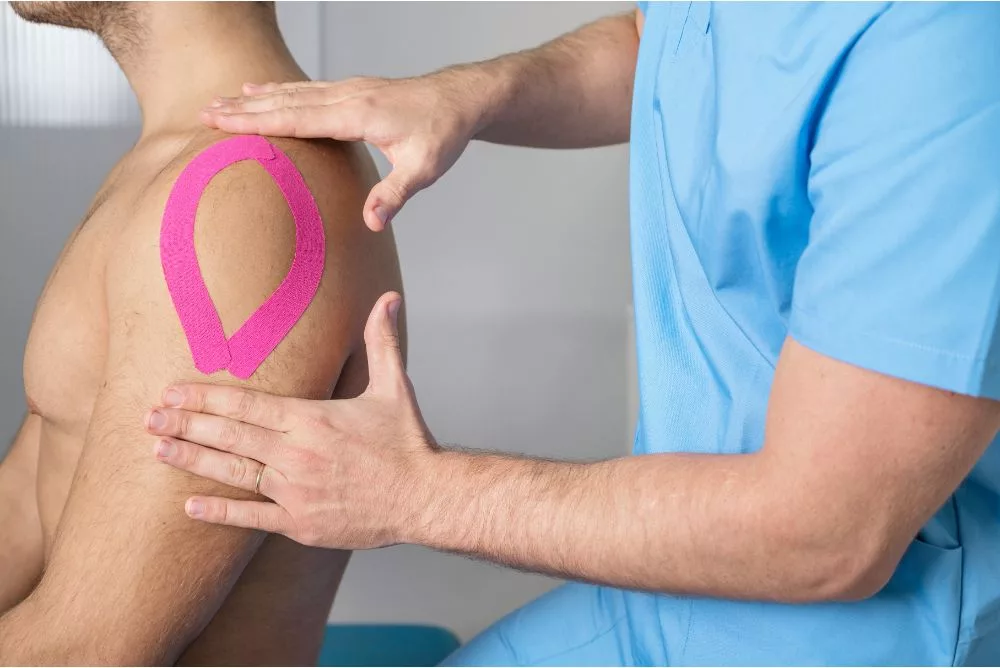
Treating Shoulder Bursitis with Kinesio Taping
Shoulder pain is a very common complaint and the diagnosis and management of shoulder injuries is one of the most challenging areas of musculoskeletal medicine.
The shoulder is a complex and relatively unstable joint that every person uses extensively on a daily basis. Every time you wash your hair in the shower or reach up into a cupboard you’re aggravating the condition. Athletes in the course of a practice or competition may tweak a shoulder and strain hundreds of times. Consequently, what started as a minor strain can easily become a chronic problem. Conditions leading to shoulder pain include dislocation, separation, tendonitis, bursitis, rotator cuff, and impingement Syndrome.
What is Shoulder Bursitis
Shoulder bursitis is a condition most often caused by repetitive, minor impact on the area, or from a sudden/serious injury. Age also plays a role. An abnormal or poorly placed bone or joint (length differences in your legs or arthritis in a joint) can put added stress on a bursa sac. Bursitis is the inflammation or irritation of the bursa, a sac filled with lubricating fluid, located between tissues such as bone, muscle, tendons, and skins that decrease rubbing, friction, and irritation. Stress/inflammation from other conditions, such as rheumatoid arthritis, gout,psoriatic arthritis, thyroid disorders, or unusual medication reactions may also increase risk. Bursitis can affect other parts of the body – elbow, hip, knee and Achilles tendon (connecting calf muscles to the heel).
However, it can be treated in a number of ways – icing the injured area, avoiding activities that aggravate the problem, physiotherapy or taking over-the-counter anti-inflammatory medicines. Another most effective and convenient method used today is the Kinesiology Taping technology.
Kinesiology Taping
Invented in the 1970s by Japanese chiropractor Kenzo Kase, the Kinesio tape is a thin, stretchy athletic tape that is particularly effective for relieving muscular pain, spasms and inflammation. Used as both a therapeutic medical tape and a sports tape, it can be applied to an injury such as strained shoulder muscles, providing rapid relief of pain and inflammation.
Once applied, most kinesiology tape applications can be worn up to 5 days, providing therapeutic benefits 24/7 the entire time they’re worn. To treat the bursitis, the tape has different ways to achieve different results. By manipulating the amount of stretch in the muscle and/or the amount of stretch in the tape, a kinesiology taping application can provide pain relief, lymphatic drainage or structural support. When pain relief is the desired objective, the rule of thumb is to stretch the muscle, not the tape. This is accomplished by holding the target muscle group in a position of maximal stretch (within pain tolerance) as the tape is applied with no stretch. This gives support and stability to your joints and muscles without affecting circulation and range of motion. It exhibits its effectiveness through the activation of neurological and circulatory systems.
The tape offers several taping techniques for Shoulder Bursitis. It is recommended to start with the General Shoulder Pain technique and to continue adding tape for the other conditions until you have maximum support and comfort. These taping techniques serve to relive impingement and provide support for inflamed and strained muscles and tendons.
There are many standard brands available. Where each packet contains a set of single-use tape strips with an illustrated step-by-step instructions sheet. Each application is designed for simple taping at light tension levels. The back of each strip has cutting guides for small, medium and large individuals, making it customizable, convenient and flexible for use. It not only looks good, but it also provides relief per application for days at a time through sweat, strain and humidity, and can even be worn in water.







